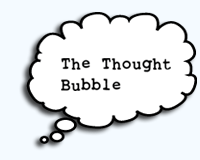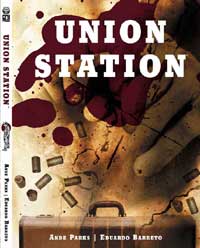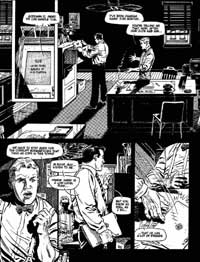- Comics
- Comics Reviews
- Manga
- Comics Reviews
- European Comics
- News
- Comics News
- Press Releases
- Columns
- Spotlight
- Digital Comics
- Webcomics
- Cult Favorite
- Back Issues
- Webcomics
- Movies
- Toys
- Store
- More
- About
By Philip Schweier
April 2, 2004 - 08:11
 Ande Parks: Railroaded Into Writing
Ande Parks: Railroaded Into Writing
 Ande Parks is one the comics industry’s most recent artist-turned-authors, and if his debut effort “Union Station” is any indication, we may very well lose a fine inker to the lure of the word-processor.
Ande Parks is one the comics industry’s most recent artist-turned-authors, and if his debut effort “Union Station” is any indication, we may very well lose a fine inker to the lure of the word-processor.
“You can blame Alan Moore, to a large degree,” says Parks. “Reading ‘From Hell’ made me want to do historical fiction. After deciding on that genre, it only made sense to focus on something in my own back yard.” The Kansas native wove his story around a grisly shooting at Kansas City’s train station in 1933.
While being transported by federal officers to prison at Leavenworth, a smalltime criminal, Frank “Jelly” Nash, was machine gunned to death, along with two local police officers and his escorts. Official reports claim Pretty Boy Floyd was one of the gunmen, though the allegation is disputed by testimony to the contrary.
Regardless, the chaos raised by interstate fugitives such as Floyd and John Dillinger reportedly gave Bureau of Investigation chief J. Edgar Hoover the ammunition to lobby for increased support of his agency. Prior to this, Hoover’s men had little law enforcement authority. With increased jurisdiction, agents were now armed and empowered to arrest.
Readers share insights to the mindset of the G-men, local police and criminals of Kansas City as the massacre’s effects are felt on ensemble cast of characters. As with many true crime stories, they share the stage equally. Readers view the shoot-out through the eyes of young reporter Charles Thompson, a fictional witness to the chain of events.
Parks was attracted to the story because, “ It’s something most people have heard of, without really knowing anything about it.” Hollywood depicted the events in the 1975 made-for-TV movie Kansas City Massacre, but unlike such historical dramatizations, Parks adheres largely to known facts. The limited embellishment allows Thompson, federal agent Reed Vetterli, Nash, and assassin Verne Miller to follow their individual paths.
The attention to historical detail in Union Station conveys a clear understanding of the Depression-era Midwest. As middle class America struggled against the effects of the economy and political corruption, real-life contemporary heroes were in short supply. Union Station makes it clear that sometimes survival after the storm is achievement enough.
After putting together a booklet consisting of an overview, one finished scene, and the entire script for the first act, Parks took his project to the 2002 San Diego Comicon where he pitched it to a number of publishers. Oni Press, known for taking on unique projects beyond the mainstream comics market, was high on Parks’ list of potential publishers.
“I had a relationship with Oni because I had done some inking with them already,” he says. “I actually heard from another publisher first, and told that company that I felt I owed it to Oni to make sure they weren’t interested before I went with anyone else.”
Oni Press editor-in-chief Jamie Rich always wanted to do a gangster comic. “I’ve always been a big fan of old crime movies, and so has our publisher Joe Nozemack,” he says. “The great thing about “Union Station” is that Ande wasn’t content to just rehash the old tropes, to work over the same ground. He was approaching it from a unique perspective.”
Parks structured the book in such a way that the story would stand apart from other crime-oriented titles, such as “Sin City” or “100 Bullets.”
“It’s more true crime along the lines of Torso than the pulpy blood and guts of those two books – both of which I read and love,” says Rich. “It’s more that we’re doing “In Cold Blood” and those guys are doing James Ellroy, and more power to all of us.”
Parks says Rich and Oni Press were great to work with. “They offered some good editorial suggestions while making sure I knew it was my project, and I was free to do it as I felt it should be done.”
 Despite his experience as an artist, Parks chose not to draw his own book. “The writer in me would not have been satisfied with me as an artist,” he explains. “Time is also a factor, since I ink Green Arrow every month.”
Despite his experience as an artist, Parks chose not to draw his own book. “The writer in me would not have been satisfied with me as an artist,” he explains. “Time is also a factor, since I ink Green Arrow every month.”
Collaborating with Parks was Uruguayan artist Eduardo Barreto, who is no stranger to the era of the 1930s. Among his Depression-era works are 1996’s “Batman: Scar of the Bat” by Max Allan Collins, an Elseworlds tale set in Chicago’s gangster era, and “The Shadow Strikes.”
“It was an easy choice,” says Parks. “Ed just happened to write Oni looking for work at the right time. I loved his work on The Shadow Strikes, so I knew he could handle the era material.”
“It was like the clouds had opened and this wonderful treasure dropped in our lap,” says Rich. “I worked with Eduardo backed at Dark Horse. It was a real treat. He’s such a consummate and professional artist,”
As a comics artist, Parks may have had preconceived visions of the page, but he has high regard for the work Barreto turned in. While usually very close to the writer’s expectations, Baretto never disappointed. “When it was different, it was often better,” Parks says. “I was really lucky to find a collaborator who understood the era, and was able to put the world on the page convincingly.”
“We’ve already got him on another Oni book,” says Rich, calling “Union Station” some of the best work of Barreto’s career. “And Ande has certainly picked up some new fans as a writer.”
But fans of his work on Green Arrow, fear not. He obviously enjoys his current run with DC’s Emerald Archer, and working with top talent such as Kevin Smith, Brad Meltzer and current writer Judd Winick. “I’ve been pretty lucky there,” he says. “I hope Phil Hester and I will be doing it for quite a while! We love the people we work with, and Ollie is such a unique hero.”
But penning additional books lie in Parks’ future. “I do plan on doing it again,” he says, “and I hope my career will slowly move more in that direction.” He is currently researching for his next project, which will also be historical fiction. •
Praise and adulation? Scorn and ridicule? Email me at philip@comicbookbin.com.
Past Articles by Philip Schweier